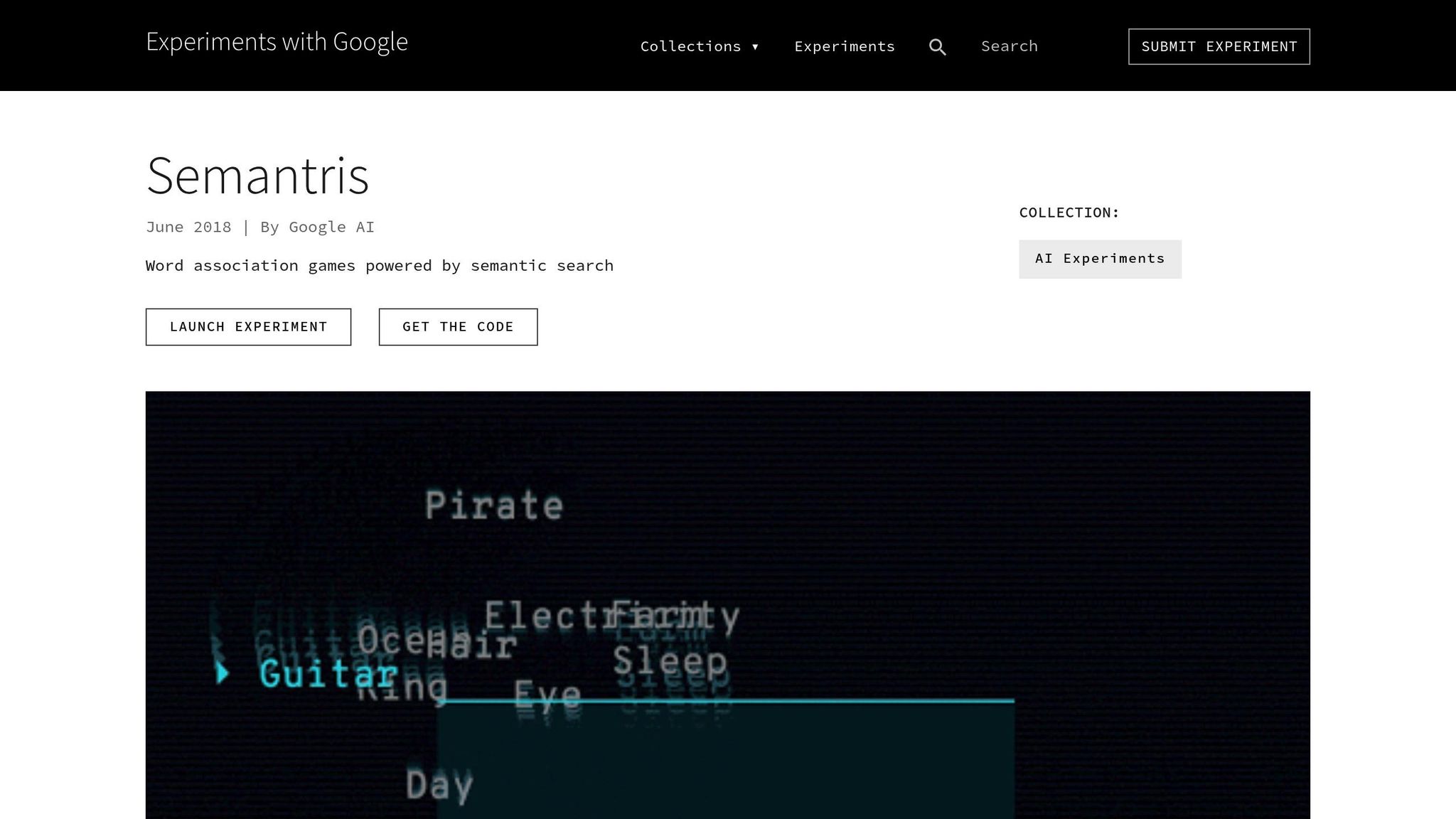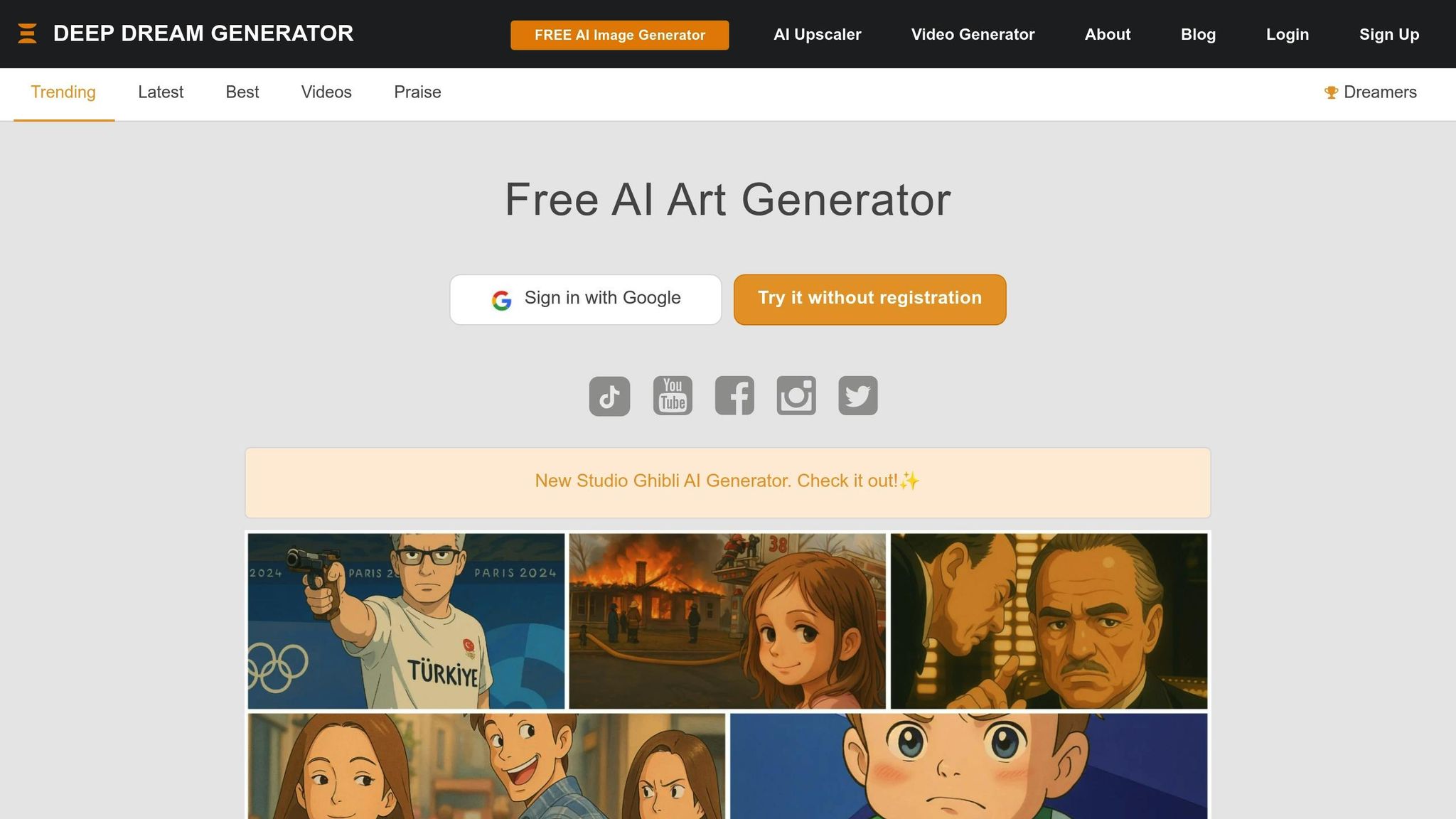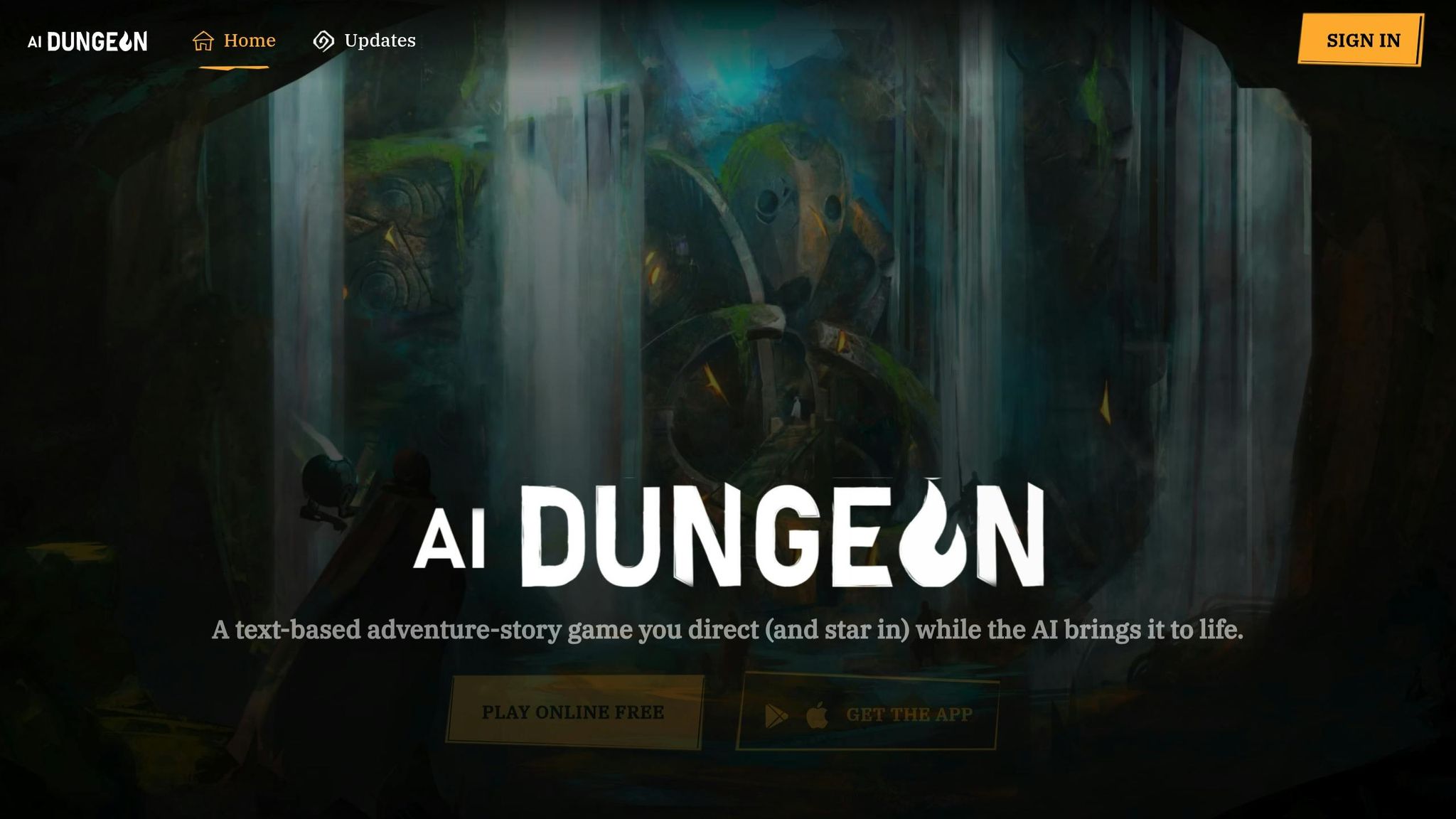Ever feel bored and want to try something fun and interactive online? Here are 5 AI-powered websites that can entertain you while showcasing the cool things AI can do:
- Quick, Draw!: A game where you sketch an object in 20 seconds, and AI guesses what it is.
- Semantris: Word association games with two modes - Arcade (fast-paced) and Blocks (puzzle-like).
- Deep Dream Generator: Turn your photos into surreal, dream-like art using AI.
- AI Dungeon: Create and control your own interactive stories with AI-generated narratives.
- This Person Does Not Exist: A website that generates realistic human faces that aren’t real.
These websites are free or easy to access and offer unique ways to explore AI. Whether you’re into games, art, or storytelling, there’s something here to try today.
1. Quick, Draw! by Google
How it works
Quick, Draw! is an interactive game that lets you experience how machine learning works in a fun and engaging way. The premise? You have 20 seconds to sketch a given object, while an AI tries to guess what you’re drawing. Developed by Google Creative Lab and the Data Arts Team - including contributors like Jonas Jongejan, Henry Rowley, and Takashi Kawashima - this game highlights how AI learns from human input and creativity.
AI recognition features
The AI behind Quick, Draw! has been trained on a massive collection of doodles, enabling it to recognize a wide range of drawing styles. And here’s the cool part: the more people play, the smarter it gets. Each new sketch helps the AI improve its ability to interpret different artistic approaches and creative quirks.
Getting started
Want to give it a try? Here’s how you can jump in:
- Head to the Quick, Draw! website.
- You’ll be prompted to draw a specific object.
- Use the 20-second timer to complete your sketch.
- Watch as the AI guesses what you’ve drawn in real time.
- Afterward, see how the neural network interpreted your doodle compared to others.
Entertainment aspects
What makes Quick, Draw! so engaging is the combination of its fast-paced challenge and the fun of real-time interaction with AI. Each round is a unique experiment, testing how well the AI can recognize your drawing. Plus, your sketches don’t just disappear - they’re added to a public dataset that helps refine the AI further. So, every time you play, you’re not just having fun; you’re also contributing to the ongoing development of the system.
8 Crazy AI Websites That Will Blow Your Mind!
2. Semantris by Google AI

Semantris, following the success of Quick, Draw!, adds a fresh spin with its word-based challenges.
Game Mechanics
Semantris puts your vocabulary to the test with two engaging modes powered by AI. In Arcade mode, players race against the clock, typing related words before their screen fills up with terms. Blocks mode, on the other hand, offers a Tetris-inspired setup where players clear colored blocks by entering associated words. This mode provides a unique opportunity to see AI's language processing in action.
AI Word Processing
The AI behind Semantris uses advanced natural language understanding, trained on billions of conversational examples. It evaluates player responses by analyzing word equivalence, similarity, and the relationships between ideas, showcasing its ability to map semantically similar phrases.
How to Play
- Arcade Mode: Type related words as quickly as possible to keep the screen from filling up and to rack up points.
- Blocks Mode: Enter words that connect to the terms on the colored blocks to clear them and progress.
Fun Factor
"The point of it isn't to collect data - we're not training models with the words people enter or selling it to anyone. This is just a demo to show how far AI has advanced in terms of understanding natural language".
Semantris not only challenges your vocabulary and creativity but also highlights how far AI has come in understanding and processing language. It’s a fun, interactive way to experience the capabilities of modern AI.
3. Deep Dream Generator

Main Functions
Deep Dream Generator turns ordinary photos into surreal pieces of art, offering three distinct processing styles. Deep Dream mode enhances recognized patterns, creating trippy, psychedelic visuals. Deep Style allows you to blend the artistic essence of one image into another, while Thin Style focuses on maintaining more of the original details during the transformation.
The platform also features a community gallery where users can showcase and explore creative experiments. For those looking for more, premium subscriptions are available, costing between $19 and $39 per month. These plans unlock high-resolution outputs and additional tools.
AI Image Processing
Behind the scenes, Deep Dream Generator uses cutting-edge AI technology. It relies on convolutional neural networks (CNNs) to create its signature effects. By reversing these networks, the system amplifies patterns in images, resulting in surreal and visually striking transformations.
User Interface
Navigating Deep Dream Generator is simple and user-friendly. The dashboard lets you pick from different processing styles and tweak settings using sliders, tooltips, and a preview feature. The platform’s mobile-friendly design, combined with its dark-themed interface, ensures the colorful AI-generated artwork pops while making it easy to access your creations, the community gallery, and account settings.
Output Options
When it comes to saving and sharing your creations, Deep Dream Generator offers plenty of flexibility:
| Feature | Free Tier | Premium Tier |
|---|---|---|
| Download Formats | JPEG, PNG | JPEG, PNG with transparency |
| Resolution | Basic | High-resolution options |
| Sharing Options | Community gallery, social media | Includes additional commercial rights |
| Organization | Basic collections | Advanced collections and favorites |
For added convenience, integrated printing services are available. You can also share your work through direct links or post it on platforms like Facebook, Twitter, and Pinterest.
sbb-itb-212c9ea
4. AI Dungeon

Game Setup
AI Dungeon pulls you into its storytelling world right from the start. You can dive in with Quick Start, where you choose a setting, character, and name, or browse through hundreds of scenarios created by the community in the Discover section. To get started, simply create an account. For extra tips and support, you can also join the official AI Dungeon Discord. Once everything is set up, the AI begins weaving a narrative based entirely on your input.
Story Generation
What sets AI Dungeon apart is its ability to generate stories that shift and grow with every command you make. Unlike traditional games that rely on fixed choices, this AI adapts in real time to create a completely unique adventure each time you play.
Player Controls
You have several tools at your disposal to shape and refine your story:
| Control Feature | Function |
|---|---|
| Undo/Redo | Go back or revisit recent story developments |
| Retry | Request a new response from the AI |
| Edit | Make changes to existing parts of the story |
| Memory | Save key plot details for the AI to remember |
| Story Cards | Organize and track important narrative elements |
Game Modes
These controls enhance your storytelling experience across two main modes:
-
Adventure Mode
This is your classic RPG-style gameplay. You guide your character's actions using Do or Say commands, while the AI takes care of the world around you, including other characters. It's perfect for an immersive role-playing experience. -
Story Mode
If you're looking for more creative freedom, Story Mode is for you. Here, you can craft detailed scenes, introduce multiple characters, and shape the narrative exactly how you want. It's a go-to for writers or anyone who loves detailed storytelling.
Both modes make use of Plot Components and Story Cards to keep your story organized and flowing smoothly from start to finish.
5. This Person Does Not Exist

Site Features
This Person Does Not Exist leverages NVIDIA's StyleGAN technology to create hyper-realistic human faces that don't actually belong to real people. The website's clean and simple interface is designed to do one thing: generate lifelike portraits. Behind the scenes, it uses two neural networks - one to create the images and another to evaluate them - resulting in increasingly convincing results.
AI Face Generation
StyleGAN, the algorithm powering this tool, was introduced by NVIDIA in 2018. It works by tweaking over 100 hidden parameters, including facial features like position, identity, and gender. Trained on a massive dataset of human faces, the AI is capable of producing images that can easily deceive both casual viewers and even professional photographers.
How It Works
Using the site is incredibly straightforward:
- Visit the website: As soon as you land on the page, a unique AI-generated face appears.
- Refresh for a new face: Reload the page to instantly see another lifelike portrait.
This simplicity makes it easy to generate endless variations of human-like faces.
Visual Results
The portraits produced by the AI are impressively realistic but sometimes reveal small imperfections. These might include slightly off-kilter accessories, duplicated teeth, unnaturally smooth or straight hair, or distorted backgrounds - clues that hint at their artificial origin.
The images generated are in the public domain, making them free to use for presentations or creative projects, provided you include a backlink to the website. However, using these images for illegal activities, such as creating fake identification documents, is strictly forbidden.
Conclusion
AI-powered entertainment has opened up a world of possibilities, turning ordinary interactions into fascinating experiences. Each platform highlights how AI can blend technology with creativity in ways that captivate and inspire.
For instance, Quick, Draw! challenges you to see how well AI can interpret your sketches, while Semantris reveals its impressive grasp of language through fast-paced word games. Deep Dream Generator takes artistic expression to new heights, AI Dungeon offers limitless storytelling adventures, and This Person Does Not Exist stuns with its ability to create lifelike human faces from scratch.
What’s even better? Many of these platforms are free to try or easy to access, making it simple to explore cutting-edge AI tools without any upfront cost.
These websites don’t just entertain - they redefine what’s possible. Whether you’re curious about creating art, spinning stories, or simply exploring the boundaries of AI, these tools offer a glimpse into the future of how humans and AI can work together to spark creativity.
FAQs
How does the AI in 'Quick, Draw!' get better at recognizing drawings?
The AI behind Quick, Draw! sharpens its recognition abilities by analyzing millions of drawings submitted by users. By spotting patterns in how people illustrate different objects, it hones its skill in predicting what each sketch represents. With every new piece of data, it grows better at interpreting and understanding the nuances of human creativity.
What’s the difference between Arcade and Blocks modes in Semantris, and which one is tougher for beginners?
In Semantris, the game offers two distinct modes to suit different play styles. The Arcade mode is all about speed, challenging you to type related words as quickly as possible to prevent the screen from filling up. It’s fast-paced and keeps you on your toes.
On the other hand, Blocks mode takes a more laid-back approach. It’s turn-based, allowing you to take your time and carefully think through your word associations. This slower pace makes it perfect for those who enjoy a more strategic and relaxed experience.
If you’re just starting out, Arcade mode might feel a bit overwhelming with its time constraints. Blocks mode, however, provides a gentler introduction, making it easier to ease into the game.
What are some creative ways to use AI-generated faces from 'This Person Does Not Exist' besides just for fun?
AI-generated faces from 'This Person Does Not Exist' open up a world of possibilities for both creative and practical applications. For instance, they’re perfect for crafting realistic placeholders in design projects like website templates, advertisements, or social media mockups. By using these images, designers can avoid relying on real photos, which helps protect privacy and sidestep ethical concerns.
These faces also come in handy for testing AI models or software that needs human-like images. Since they don’t depict real people, they provide a safe and ethical way to train or evaluate systems without the complications of using actual photos.
On the creative side, these lifelike images can inspire storytelling or character development in writing, gaming, or visual media. Their realistic appearance makes them a powerful tool for sparking fresh ideas or adding depth to creative projects.



